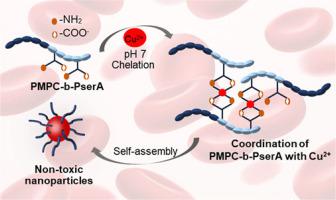Biomaterials Advances ( IF 7.9 ) Pub Date : 2021-08-20 , DOI: 10.1016/j.msec.2021.112367 Shing-Yu Kuo, Pin-Chun Chen, Kang-Ting Huang, Chun-Jen Huang

|
We developed a hemocompatible, bio-inspired, multivalent, polymeric-chelating assembly based on the poly(2-methacryloyloxyethyl phosphorylcholine)-b-poly(serinyl acrylate) (PMPC-b-PserA) zwitterionic diblock copolymer. Functional PMPC-b-PserA was synthesized via reversible addition-fragmentation chain transfer (RAFT) polymerization to catch and encapsulate free copper ions (Cu2+) in a solution. PMPC with an identical polar group to phospholipids exhibits high hydrophilicity and fouling resistance against non-specific adsorption, and inertness to the metal ions. On the other hand, PserA with pendant groups of amino acids possesses a strong capability to react with Cu2+ by coordination interaction. Therefore, when PMPC-b-PserA was brought into contact with Cu2+, a hydrophobic core with multiple coordination “bridges” between polymers and Cu2+ was formed, leading to self-assembly of core-shell polymer-metal nanoparticles. As a result, free Cu2+ ions can be removed from the solution to prevent damage to cells and tissues. The synthesis and chemical structure of PMPC-b-PserA were characterized, and the formation of self-assembled polymer-Cu2+ nanoparticles and colloidal stability were analyzed. More importantly, the detoxification of PMPC-b-PserA in presence of Cu2+ with fibroblast cells was demonstrated by increased cell viability >80%. In addition, the hemolysis, which occurred due to disruption of RBC membranes by free Cu2+, was effectively suppressed by adding PMPC-b-PserA. The bio-inspired and biocompatible chelating agent of PMPC-b-PserA provides a new treatment approach to encapsulate and detoxify heavy metals in complex media for chelation therapy.
中文翻译:

生物启发的两性离子聚合物螯合组件用于治疗铜诱导的细胞毒性和溶血
我们开发了一种基于聚(2-甲基丙烯酰氧基乙基磷酸胆碱)-b-聚(丙烯酸丝氨酸酯)(PMPC-b-PserA)两性离子二嵌段共聚物的血液相容性、仿生、多价、聚合螯合组件。功能性 PMPC-b-PserA 是通过可逆加成-断裂链转移 (RAFT) 聚合合成的,以捕获和封装溶液中的游离铜离子 (Cu 2+ )。与磷脂具有相同极性基团的 PMPC 表现出高亲水性和抗非特异性吸附抗污性,以及对金属离子的惰性。另一方面,带有氨基酸侧基的 PserA 具有通过配位相互作用与 Cu 2+反应的强大能力。因此,当 PMPC-b-PserA 与 Cu 2+接触时,在聚合物和Cu 2+之间形成具有多个配位“桥”的疏水核,导致核-壳聚合物-金属纳米颗粒的自组装。因此,可以从溶液中去除游离的 Cu 2+离子,以防止对细胞和组织造成损害。表征了PMPC-b-PserA的合成和化学结构,并分析了自组装聚合物-Cu 2+纳米粒子的形成和胶体稳定性。更重要的是,PMPC-b-PserA 在 Cu 2+存在下对成纤维细胞的解毒作用通过细胞活力增加 > 80% 来证明。此外,由于游离 Cu 2+破坏红细胞膜而发生的溶血, 通过添加 PMPC-b-PserA 被有效抑制。PMPC-b-PserA 的仿生和生物相容性螯合剂提供了一种新的治疗方法,可在复杂介质中封装和解毒重金属以进行螯合治疗。


























 京公网安备 11010802027423号
京公网安备 11010802027423号